Time Travel Research Center © 2005 Cetin BAL - GSM:+90 05366063183 -Turkey/Denizli
Quantum Field Theory
Contents
The Field Equation
Quantization
Green's Function and Renormalization
Perturbation Theory and S Matrix
Feynman Diagram
Quantum Electrodynamics (QED)
A Very Brief Overview of the Standard Model
The Field Equation
Quantum Field Theory can be considered as "field + quantization".
Followings is a mathematical formulation (at 2nd year undergraduate level)
on the construction of quantum field and its application to elementary
particle physics.
The dynamic of the field is determined by the field equation. The field
equation for the neutral scalar meson field is a very simple kind of Klein-Gordon
Equation as shown below:
| ---------- (1) |
where m is a parameter related to the mass,
![]() is the field, which is a
complex function (with real and imaginary parts) of x, y, z, and t (simply
represented by x in the equation),
is the field, which is a
complex function (with real and imaginary parts) of x, y, z, and t (simply
represented by x in the equation),
 , and
, and

are the Laplacians in four dimensional space-time and three dimensional
space respectively. The wave equations and many systems in physics and
engineering are constructed with these Laplacian operators.
The field can be expressed in a series expansion in terms of the harmonic
functions and the coefficients ck's, where k is a four
dimensional vector related to the momentum and energy of the particle:
 |
---------- (2) |
which is just a Fourier Series where the coefficients are to be
determined by the field:
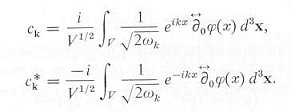 |
---------- (3) |
Quantization
Quantization of the field is accomplished by demanding the coefficients ck's
to satisfy the following commutation rules:
| ---------- (4) |
If a number operator Nk = ck*ck is
defined such that it operates on the state vector |nk> to
generate:
Nk|nk> = nk|nk>
where nk is the number of particles in the k state; it can be
shown that
ck*|nk> = (nk+1)1/2|nk+1>
ck|nk> = nk1/2|nk-1>
Thus ck* increases the number of particles in the k state by 1,
while ck reduces the number of particles in the k state by 1.
They are called creation and annihilation operator respectively. The
complete set of eigenvectors is given by:
 |
---------- (5) |
for all values of kl and nl. They
form an abstract space called the Hilbert space with all the eigenvectors
orthogonal (perpendicular) to each others and the norm (length) equal to 1.
In particular, the vacuum state is:
| ---------- (6) |
which corresponds to no particle in any state - the vacuum.
Green's Function and Renormalization
The above treatment is for the case of free field. The mathematics
becomes more complicated when there is interaction with the field. The
simplest case is to include the source of the field in the free field
equation. An additional term is inserted to the right of Eq.(1) :
| ---------- (7) |
where the label "o" designates quantities associated with the "bare field".
Invoking the Green's function technique, the solution of this equation is
given by:
| ---------- (8) |
where the first term is the free field solution and the Green's function
inside the integral is the solution of the equation with a point source at
point y in the general form:
| ---------- (9) |
where the delta function on the right hand side equals to 1 for x = y,
and 0 otherwise.
It can be shown that the "bare field" can be expressed in terms of ck's
similar to the case of the free field, but these coefficients are now
modified by an additional term related to the structure of the source. As a
result the norm (length) of the eigenvectors are no longer equal to 1. To
recover this definition, they have to be "renormalized" by the
renormalization constant Z1/2, which has the values
![]() in general; it is equal to 1 for
free field and 0 for a point source. The renormalized field, mass, and
energy are
in general; it is equal to 1 for
free field and 0 for a point source. The renormalized field, mass, and
energy are ![]()
![]() and EnR = Z-1Eno
respectively. The physical mass mR is the experimentally observed
mass, mo is an unspecified parameter (called "bare mass") which
together with Z-1 determine a value in agreement with experiment.
In a realistic, fully quantized system, perturbation theory must be used to
obtain any numerical result. However, it is found that perturbation theory
calculations always lead to an infinity value for Z so that the ''bare"
quantities such as mo would also be infinity to yield a finite
value for mR.
and EnR = Z-1Eno
respectively. The physical mass mR is the experimentally observed
mass, mo is an unspecified parameter (called "bare mass") which
together with Z-1 determine a value in agreement with experiment.
In a realistic, fully quantized system, perturbation theory must be used to
obtain any numerical result. However, it is found that perturbation theory
calculations always lead to an infinity value for Z so that the ''bare"
quantities such as mo would also be infinity to yield a finite
value for mR.
Perturbation Theory and S Matrix
It is not possible to obtain an analytical solution for the field
equation with the field itself in the interaction term. A perturbation
theory was developed to obtain approximate solutions step by step. The
interaction between a charged fermion and the photon is in the form
![]() , where A is the
electromagnetic vector potential and
, where A is the
electromagnetic vector potential and
![]() is the field for the fermion,
which appears on both side of the Green's function solution as shown in Eq.(8).
An iteration procedure yields a sum of integrals as shown in the formula
below:
is the field for the fermion,
which appears on both side of the Green's function solution as shown in Eq.(8).
An iteration procedure yields a sum of integrals as shown in the formula
below:
 |
---------- (10) |
where K is the Green's function. In this form the unknown field on the
left hand side is now expressed in terms of all known quantities on the
right hand side. The first term is the free field solution, and the
integration is over all the space-time x', x'', x''',
... Note that each of the following term is multiplied by the power of e,
from e1, to e2, ... Since e=1/137 for the
electromagnetic interaction, computation on a few terms would be sufficient
to obtain a result with acceptable accuracy.
Another formulism is the S-matrix theory, which was very popular many years
ago. It is the transition probability expressed in an expansion as the
result of the iteration procedure on the transition operator, which
transforms the system from an initial state (at time negative infinity) to a
final state (at time positive infinity) as shown in the formula below.
 |
---------- (11) |
where HI involves the interaction fields (integrating over all
space and multiplied by the coupling strength) and
t1 > t2 > ... > tn-1. In this picture the
fields obey the free field equations, the interaction enters via HI.
It was thought that since we cannot measure the fields directly, so we
should not talk about it, while we do measure S-matrix elements, so this is
what we should be mindful about. It is now realized that analyzing the S-matrix
alone is not sufficient, information on the quantum fields is also necessary.
It can be shown that the various orders in the S-matrix are related to the
petrubation expansion in Eq.(10).
Let us take the nucleon-pion system as an example of S-matrix application:
|
|
---------- (12) ---------- (13) |
where Eq.(12) is the free field equation for the pion, and Eq.(13) is the
free field equation for the nucleon (the Dirac equation). Expressing in
terms of the field itself, it can be shown that the quantization rules in Eq.(4)
become:
 |
---------- (14) |
where {a,b} = ab + ba is the anticommunition expression, and the
quantities on the right-hand side are the Green's functions for the pion and
nucleon respectively. Since the interaction is go![]() the nth order term in the S-matrix expansion Eq.(11) has the explicit form:
the nth order term in the S-matrix expansion Eq.(11) has the explicit form:
 |
---------- (15) |
where the symbol N is the normal-order operator, which shifts all the
creation operators to the left (to avoid infinite vacuum energy), while T is
the time-order operator, which re-arranges the fields so that the one
associated with later time is on the left (to take care of the integration
limits in Eq.(11)).
Feynman Diagram
The first order term is:
| ---------- (16) |
The mathematical entities inside the integral can be represented
graphically by the following conventions:

which translates S(1) into a graph called the Feynman diagram:
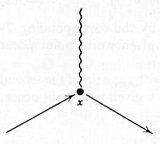
It represents the process of the annihilation of a pair of nucleon and anti-nucleon
and the creation of a pion.
In the next higher order term the normal operator will sometimes produces a
Green's function such as ![]() . This is
usually referred to as propagator and graphically represented by a wavy line
running from x to y as show below:
. This is
usually referred to as propagator and graphically represented by a wavy line
running from x to y as show below:

which corresponds to the scattering of two nucleons by exchanging a pion.
Another graph such as the one below:

represents the process of virtual pair creation and annihilation - the
vacuum fluctuation.
The Feynman rules are summarized in the table below:

where the + and - superscripts refer to the positive frequency (eikx)
and negative frequency (e-ikx) expansion in Eq.(2), N represents
the nucleon and ![]() represents the
anti-nucleon.
represents the
anti-nucleon.
Feynman diagrams can be divided into two types, "trees" and "loops", on the
basis of their topology. Tree diagrams have no loops; that is, they only
have branches. They describe process such as scattering, which yields finite
result and reproduces the classical value. Loop diagrams, as their name
suggests, have closed loops in them such as the one for vacuum fluctuation.
The process in "loops" diagrams involves virtual particles and is usually
divergent (becomes infinity at some limits). The infinities are removed by
the renormalization precedure similar to the mass renormalization mentioned
earlier. Virtual particles can appear and disappear violating the rules of
energy and momentum conservation as long as the uncertainty principle is
satisfied. They are said to be "off mass-shell", because they do not satisfy
the relationship E2 = p2c2 + m2c4.
Quantum Electrodynamics (QED)
Quantum electrodynamics, or QED, is a quantum theory of the interactions
of charged particles with the electromagnetic field. It describes
mathematically not only all interactions of light with matter but also those
of charged particles with one another. QED is a relativistic theory in that
Albert Einstein's theory of special relativity is built into each of its
equations. That is, the equations are invariant under a transformation of
space-time. The QED theory was refined and fully developed in the late 1940s
by Richard P. Feynman, Julian S. Schwinger, and Shin'ichiro Tomonaga,
independently of one another. Because the behavior of atoms and molecules is
primarily electromagnetic in nature, all of atomic physics can be considered
a test laboratory for the theory. Agreement of very high accuracy makes QED
one of the most successful physical theories so far devised.
The formulism for QED is very similar to the nucleon-pion system in Eqs.(12)
and (13). While Eq.(13) for fermion is readily applicable (with appropriate
value for ko, which is proportional to the mass of the fermion);
Eq.(12) is replaced by the Maxwell equations:

where E, B are the electric and magnetic field respectively,
j is the current density, rho is the charge density, and c is the
velocity of light.
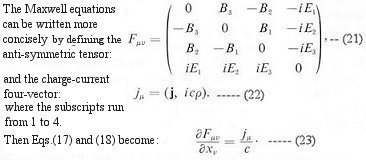
By virtue of the antisymmetry of Eq.(21), the continuity equation for the
charge-current density is automatically satisfied, i.e.,
![]()
The vector potential is introduced by:
| ---------- (24) |
This definition is used for simplifying computations. It incorporates Eqs.(19)
and (20) into the formulism automatically. There is arbitrariness when the
Maxwell equations are written in this form. By imposing particular
conditions to the arbitrariness,
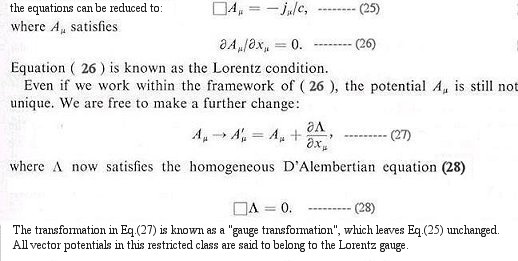
The vector potential A can always be decomposed into a transverse
component and a longitudinal component (with respect to the direction of
motion) as shown in Eq.(29) such that Eqs.(30) and (31) are satisfied:

It can be shown that the longitudinal component and Ao
together give rise to the instantaneous static Coulomb interactions between
charged particles, whereas the transverse component accounts for the
electromagnetic radiation of moving charged particles. The transverse
electromagnetic fields provides a simple and physically transparent
descriptions of a veaiety of processes in which real photons are emitted,
absorbed, or scattered. The three basic equations for the free-field case
are:

where A satisfies the transversality condition in Eq.(30).
Eq.(33) is in a form very similar to the Klein-Gordon Equation Eq.(1) or Eq.(12)
except that the mass term vanishes (because the photon has no rest mass) and
the field is a vector (instead of scalar) with two transverse components (polarization)
perpendicular to each other. Thus A can be expressed in Fourier
series similar to Eq.(2): 
The quantization rules for the electromagnetic field is very similar to that
in Eq.(4):
| ---------- (36) |
where the ak's are related to the ck's by:
| ---------- (37) |
Construction of the eigenvectors follows exactly the same way as in Eqs.(5)
and (6) with an additional index for polarization.
Interaction between photon and fermion, e.g., electron can be introduced by
demanding local gauge invariance for the formulism. With this constraint on
the quantum field theory, the ordinary derivative in Eq.(13) becomes the
covariant derivative:
![]()
and the interaction takes the form:
![]()
where e is the coupling constant. (See appendix on "Abelion/non-Abelion
Groups and U(1), SU(2), SU(3)" for a discussion about the concept of
gauge or phase transformation.)
- The first order processes -

where the electron field has been decomposed to:

and the symbol X may stand for an interaction with an external classical potential, the emission of a photon, or the absorption of a photon. The realization of a particular process depends entirely on the initial and final states.
- The second order processes -


- Two-photon annihilation - Pair of an electron and positron into two gamma rays.
- Compton scattering - It occurs when an electron and a photon collide and scatter elastically.
- Moller scattering - It is the scattering of two relativistic electrons.
- Bremsstrahlung - It is the process by which radiation is emitted from an electron as it moves past a nucleus.
- Higher order processes -
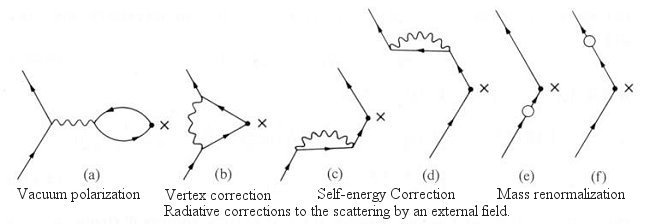
- Vacuum polarization - It produces a correction to the coupling constant (electric charge) and contributes to the Lamb shift, which is a small splitting of hydrogen atom energy levels caused by the interaction with the virtual pair (of electron and positron).
- Vertex correction - A correction to the electron vertex function, which contributes to the anomalous electron magnetic moment.
- Self-energy - The interaction of a charged particle with its own field and it usually gives rise to infinite self-energy and infinite mass.
- Mass renormalization - The observed mass is generated by combining the bare mass and the (calculated) divergent mass.
The photon-electron processes are described by substituting Eq.(39) to
HI in the S matrix expansion Eq.(15):
In summary QED rests on the idea that charged particles (e.g., electrons and positrons) interact by emitting and absorbing photons, the particles of light that transmit electromagnetic forces. These photons are virtual; that is, they cannot be seen or detected in any way because their existence violates the conservation of energy and momentum. The particle exchange is manifested as the "force" of the interaction, because the interacting particles change their speed and direction of travel as they release or absorb the energy of a photon. Photons also can be emitted in a free state, in which case they may be observed. The interaction of two charged particles occurs in a series of processes of increasing complexity. In the simplest, only one virtual photon is involved; in a second-order process, there are two; and so forth. The processes correspond to all the possible ways in which the particles can interact by the exchange of virtual photons, and each of them can be represented graphically by means of the Feynman diagrams. Besides furnishing an intuitive picture of the process being considered, this type of diagram prescribes precisely how to calculate the observable quantity involved.
A Very Brief Overview of the Standard Model
It is beyond the scope of this webpage to present a comprehensive review
of the Standard Model. The following is a crude attempt to provide a glance
of the subject matter by introducing the Lagrangian density
![]() Standard Model for
the Standard Model. The field equations are derived by minimizing the "Action'' , which is
related to the Lagrangian density. Thus instead of writing down the field
equations explicitly such as in Eqs.(17) - (20) or Eqs.(13) and (38), the
dynamics of the electro-weak interaction can be expressed in term of the
Lagrangian density:
Standard Model for
the Standard Model. The field equations are derived by minimizing the "Action'' , which is
related to the Lagrangian density. Thus instead of writing down the field
equations explicitly such as in Eqs.(17) - (20) or Eqs.(13) and (38), the
dynamics of the electro-weak interaction can be expressed in term of the
Lagrangian density:
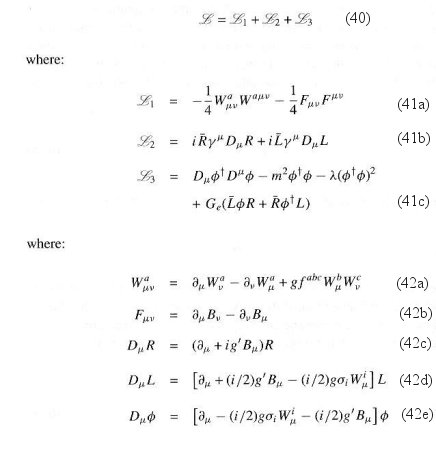
This is known as the Weinberg-Salam Model. The lepton Lagrangina density
![]() in Eq.(40) consists of three
parts.
in Eq.(40) consists of three
parts. ![]() 1 is the
gauge bosons part;
1 is the
gauge bosons part; ![]() 2
is the fermionic part; and
2
is the fermionic part; and
![]() 3
is the scalar Higgs sector, which generates mass for the gauge bosons and
the fermions.
3
is the scalar Higgs sector, which generates mass for the gauge bosons and
the fermions.
- The symbols
 and
and
 are indices for the space-time
components running from 1 to 4. Whenever an index appears in both the
subscript and superscript, it signifies a summation over these components.
are indices for the space-time
components running from 1 to 4. Whenever an index appears in both the
subscript and superscript, it signifies a summation over these components.
- Wa
 is related to the three gauge (vector) bosons with the index "a" running
from 1 to 3.
is related to the three gauge (vector) bosons with the index "a" running
from 1 to 3. - F

 is the anti-symmetric tensor for the electromagnetic field as shown in Eq.(24),
where the vector potential A
is the anti-symmetric tensor for the electromagnetic field as shown in Eq.(24),
where the vector potential A is now denoted by B
is now denoted by B .
.
- fabc is the antisymmetric tensor such that f123 = +1, f213 = -1, f113 = 0, ... etc.
- Since there is no right-handed neutrino in nature, the fermionic field
consists of a left-handed isodoublet and a right-handed isosinglet as
shown below -

---------- (42f) This curious feature, that the electron is split into two parts is a consequence of the fact that the weak interactions violate parity and are mediated by V - A interactions, where V stands for vector and A stands for axial vector (also known as pseudovector, which changes sign under a parity transformation). The axial vector interaction is hidden in the last term of Eq.(42d). The asymmetric forms for the fermion fields in Eq.(42f) is a way to portrait the chiral nature of the objects in weak interaction - the left-handed version is different from the right-handed one. Note that in Eq.(42c) the right-handed field R does not participate in the weak interaction involving the vector bosons Wa
 .
.
 are the Pauli matrices
as shown in Eq.(10) in the appendix on "Groups "
with i running from 1 to 3. The four 4X4
are the Pauli matrices
as shown in Eq.(10) in the appendix on "Groups "
with i running from 1 to 3. The four 4X4
 metrices are constructed
from the Pauli matrices and the identity matrix.
metrices are constructed
from the Pauli matrices and the identity matrix. - g and g' are the coupling constants for the SU(2) and U(1) interactions respectively.
- The first three terms in Eq(41c) are responsible for generating the mass of the gauge bosons, while the last term takes care of the fermion mass.
 is the scalar Higgs field
as depicted in the diagram below:
is the scalar Higgs field
as depicted in the diagram below:
Meaning of the symbols in the Lagrangina density
![]() :
:
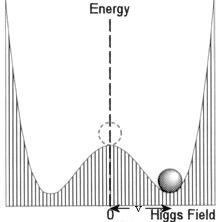
This form of field exhibits a drastic effect called "spontaneous symmetry
breaking". When the origin of the field is shifted to v by the
transformation ![]() ' =
' =
![]() - v, the fields Wa
- v, the fields Wa![]() and B
and B![]() recombine and reemerge as the physical photon field A
recombine and reemerge as the physical photon field A![]() ,
a neutral massive vector particle Z
,
a neutral massive vector particle Z![]() ,
and a charged doubled of massive vector particles W+/-
,
and a charged doubled of massive vector particles W+/-![]() :
:
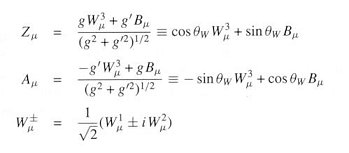
The masses of the gauge bosons are obtained from the mass sector:
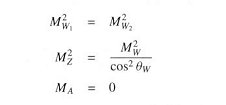
Physically, the effect can be interpreted as an object moving from the "false
vacuum" (where ![]() = 0) to the more
stable "true vacuum" (where
= 0) to the more
stable "true vacuum" (where
![]() =
v). Gravitationally, it is similar to the more familiar case of moving from
the hilltop to the valley. In the case of Higgs field, the transformation is
accompanied with a "phase change", which endows mass to some of the
particles.
=
v). Gravitationally, it is similar to the more familiar case of moving from
the hilltop to the valley. In the case of Higgs field, the transformation is
accompanied with a "phase change", which endows mass to some of the
particles.
Experimentally, the predictions of the Weinber-Salam model have been tested
to about one part in 103 or 104. It has been one of
the outstanding successes of the field theory, gradually rivaling the
predictive power of QED.
The above formulism can be carried over to the electro-weak interactions
between quarks with the massless neutrino replaced by the up quark u (which
has mass), and the electron replaced by the down quark d. In order to get
the correct quantum numbers, such as the charge, the covariant derivatives
are different from the lepton as shown below:
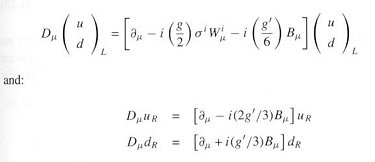
where the coupling constants g and g' are also different from the case of
leptons.
The theory for the strong interaction is called quantum chromodynamics (QCD),
which has the Lagrangian density:

Since the gauge bosons (the gluons) are massless, the Lagrangian density
appears to be in a much simpler form than the electro-weak interactions in
Eq.(40).
- Fa

 is similar to the SU(2) gauge field in Eq.(42a). This is essentially the
Yang-Mills field developed back in 1953 by generalizing the gauge
invariance used in QED. It represents the eight massless gluons carrying
the SU(3) "colour" force with the index "a" running from 1 to 8.
is similar to the SU(2) gauge field in Eq.(42a). This is essentially the
Yang-Mills field developed back in 1953 by generalizing the gauge
invariance used in QED. It represents the eight massless gluons carrying
the SU(3) "colour" force with the index "a" running from 1 to 8. - The index "i" is taken over the flavors, which labels the up, down, strange, charm, top, and bottom quarks. The flavor index is not gauged; it represents a global symmetry. However, the quarks also carry the local colour SU(3) indices red, green, and blue (which is suppressed here). In other words, quarks come in six flavors and three colours, but only the colour index participates in the local gauge symmetry. It is the colour force, which binds the quarks together.
 =
=
 .
. - mi denotes the mass for the various quarks.
Meaning of the symbols in the QCD Lagrangina density :
The Lagrangian for the Standard Model then consists of three parts:
![]()
where WS stands for the Weinberg-Salam model, and lept. and qurk. stand for
the leptons and quarks that are inserted into the WS model with the correct
SU(2)XU(1) assignments. It is assumed that both the leptons and quarks
couple to the same Higgs field in the usual way. From this form of the
Standard Model, several important conclusions can be drawn. First, the
gluons from QCD only interact with the quarks, not the leptons. Thus,
symmetries like parity are conserved for the strong interactions. Second,
the chiral symmetry, which is respected by the QCD action in the limit of
vanishing quark masses, is violated by the weak interactions. Third, quarks
interact with the leptons via the exchange of W and Z vector mesons.
Alıntı: http://universe-review.ca/R15-12-QFT.htm
Hiçbir yazı/ resim izinsiz olarak kullanılamaz!! Telif hakları uyarınca bu bir suçtur..! Tüm hakları Çetin BAL' a aittir. Kaynak gösterilmek şartıyla siteden alıntı yapılabilir.
The Time Machine Project © 2005 Cetin BAL - GSM:+90 05366063183 -Turkiye/Denizli
Ana Sayfa /İndex /Roket bilimi / ![]() E-Mail /CetinBAL /Quantum Teleportation-2
E-Mail /CetinBAL /Quantum Teleportation-2
Time Travel Technology /Ziyaretçi Defteri / UFO Technology